Optical and UV-Aging Properties of LDH-Modified Bitumen
Abstract
:1. Introduction
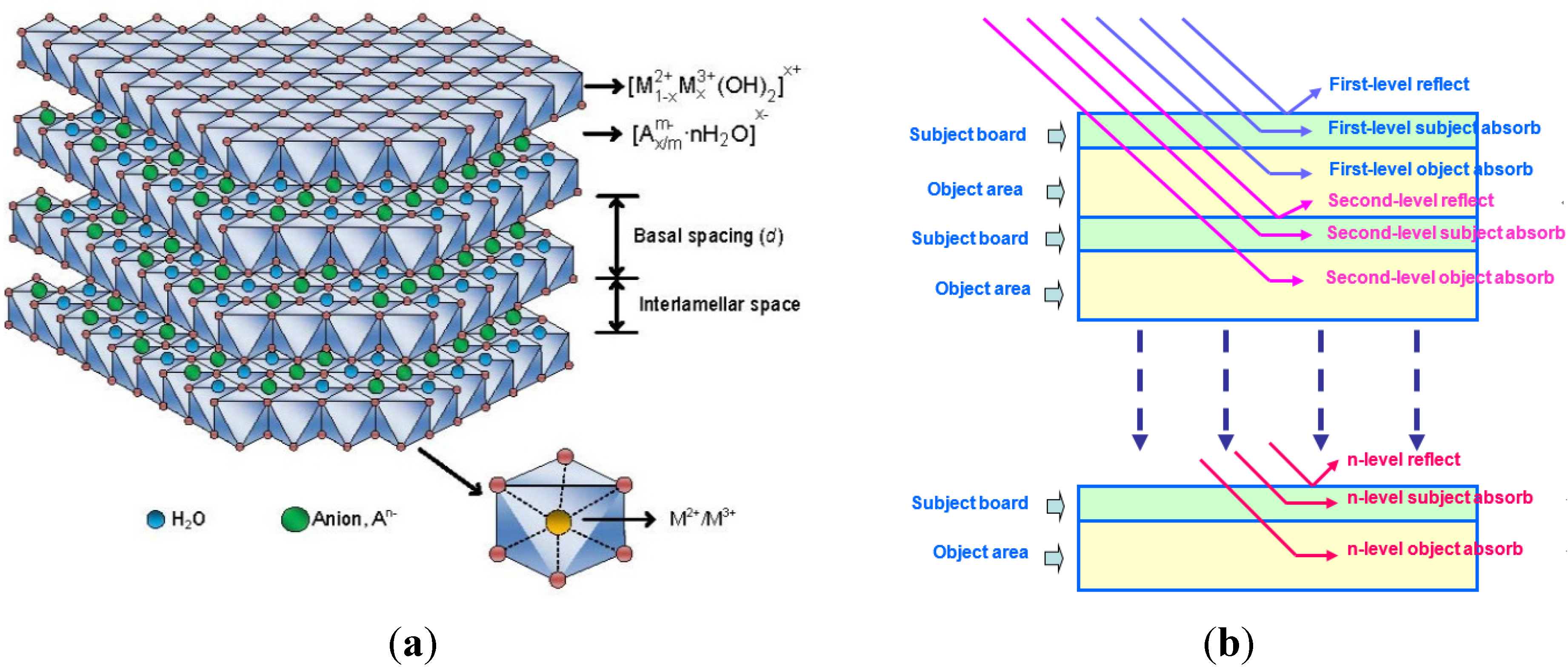
2. Materials and Test Methods
2.1. Materials and Preparation

2.2. Morphology and Optical Test
2.3. UV-Aging Properties
3. Results and Discussions
3.1. Morphology of Bitumen Film

3.2. Optical Properties of Base Bitumen
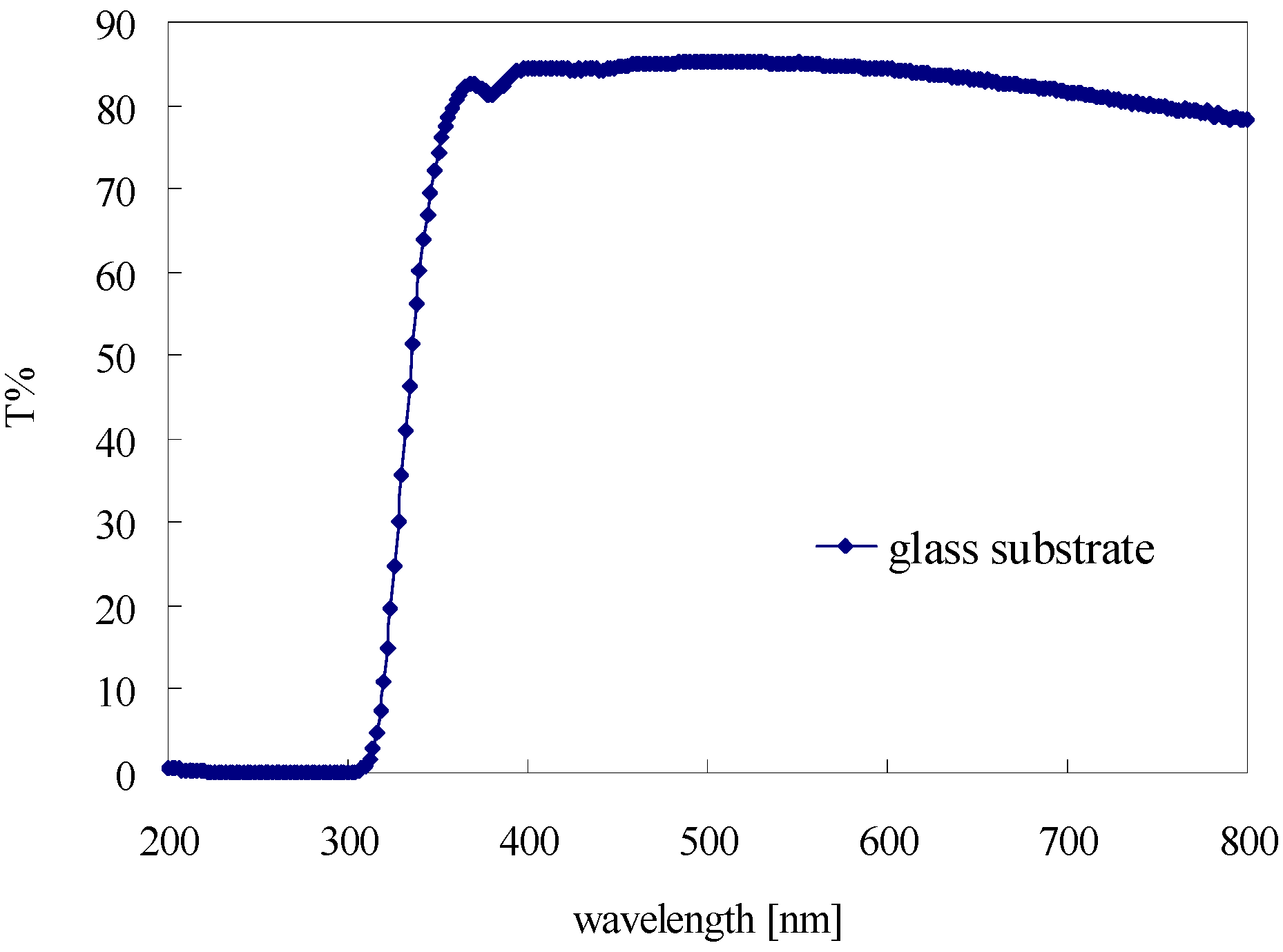
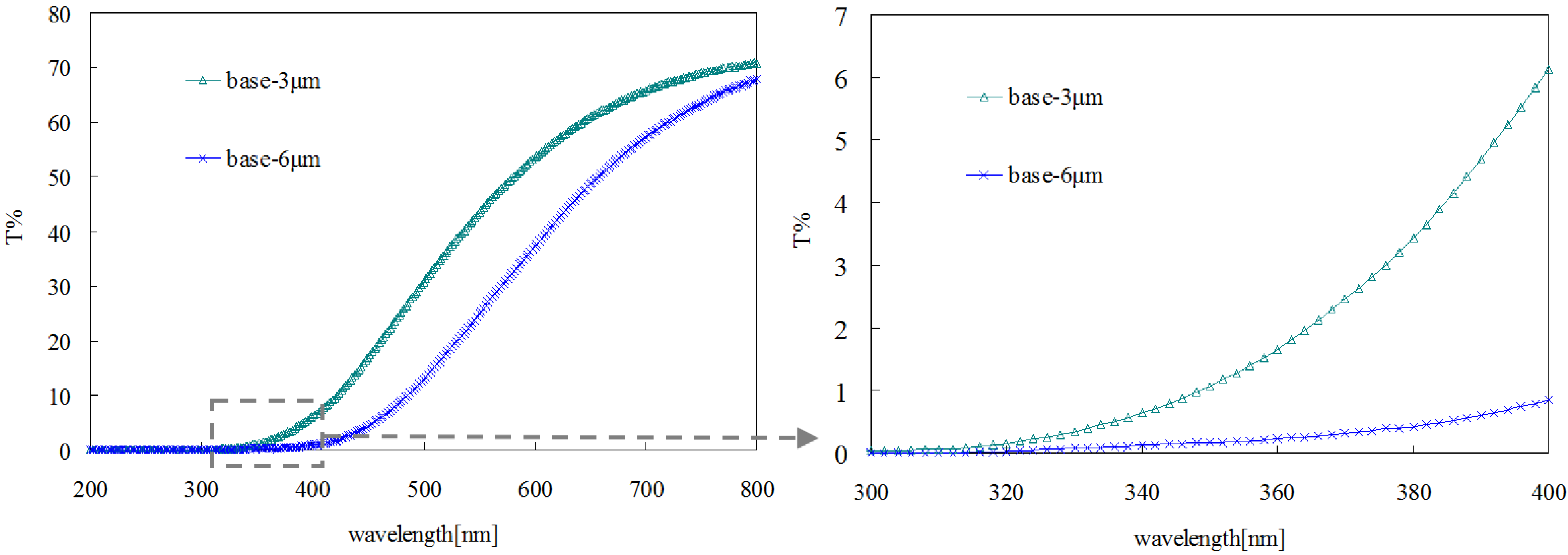
3.3. Transmittance of Modified Bitumen Film
| Parameters | Base | Base + 3% LDHs | Base + 5% LDHs |
|---|---|---|---|
| M (%) | 74.45 | 63.32 | 61.22 |
| Δ l (nm) | 266 | 276 | 264 |
| lm (nm) | 518 | 548 | 561 |
| R2 | 0.9980 | 0.9974 | 0.9979 |
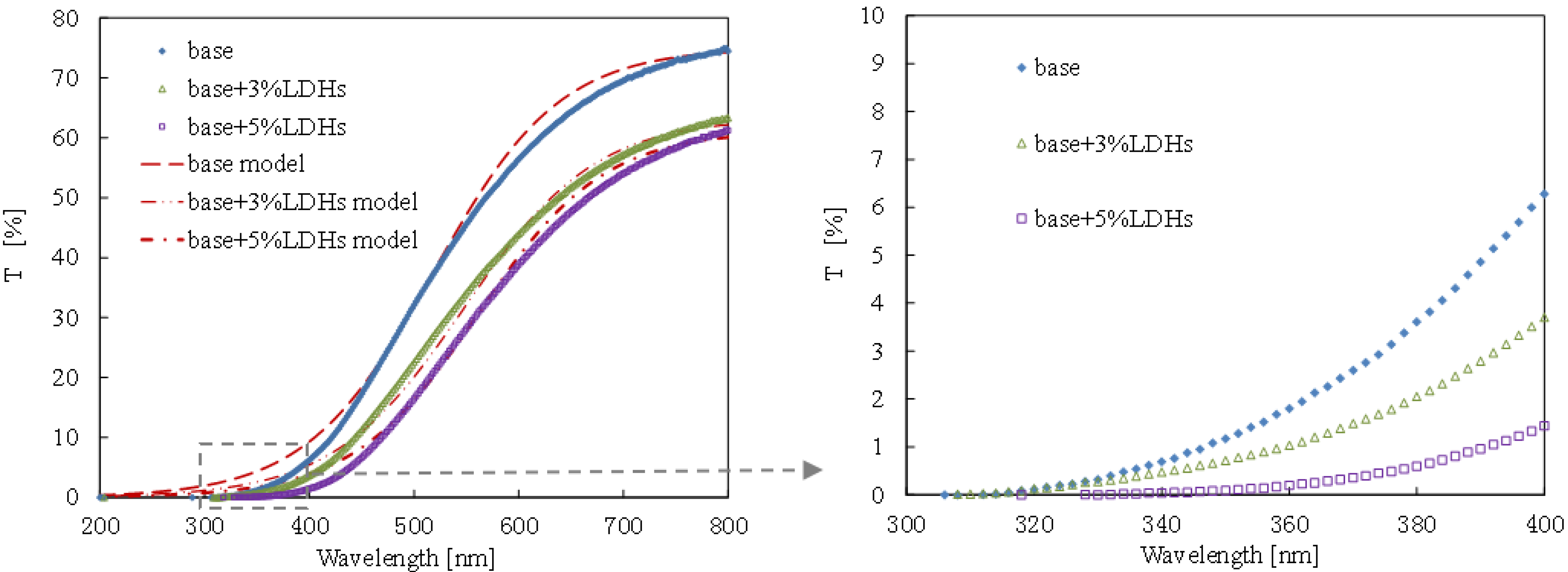
3.4. Absorbance of Modified Bitumen Film
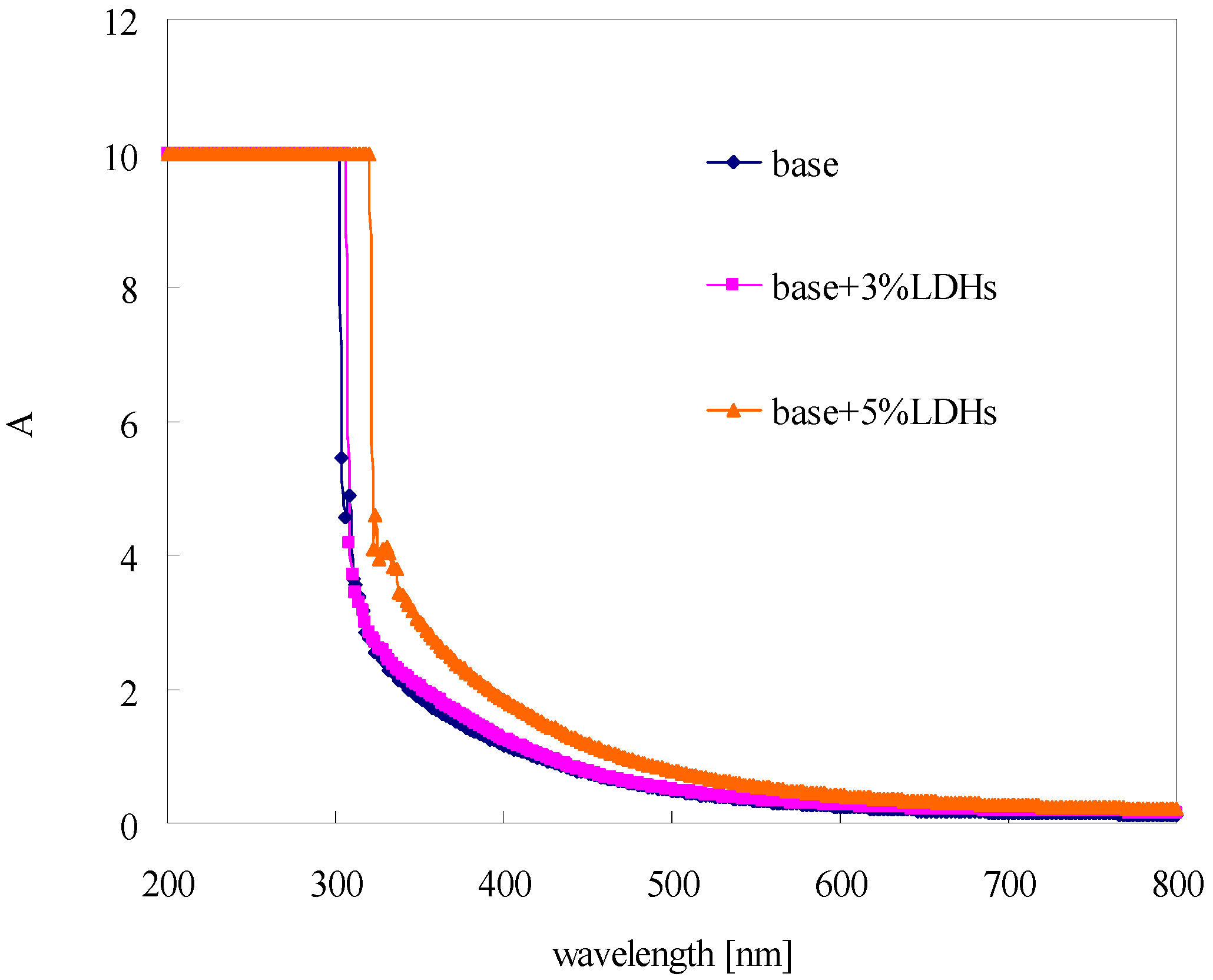
3.5. Reflectance of Modified Bitumen

3.6. UV-Aging Properties
3.6.1. Rheological Properties
| LDHs Content (wt %) | V1 of Fresh Bitumen (Pa·s) | V2 of Bitumen After UV Aging (Pa·s) | VAI (%) |
|---|---|---|---|
| 0 | 330 | 660 | 50 |
| 3 | 500 | 720 | 44 |
| 5 | 550 | 735 | 33.6 |
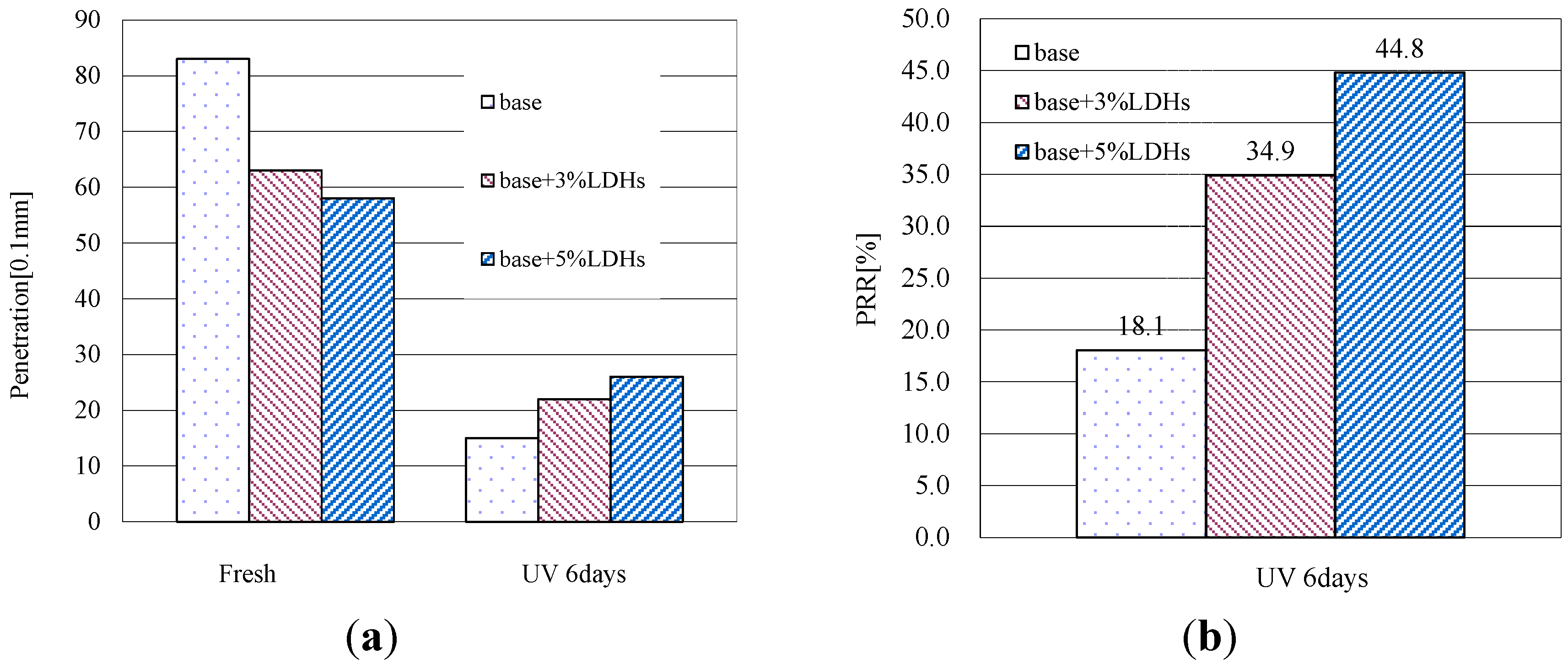
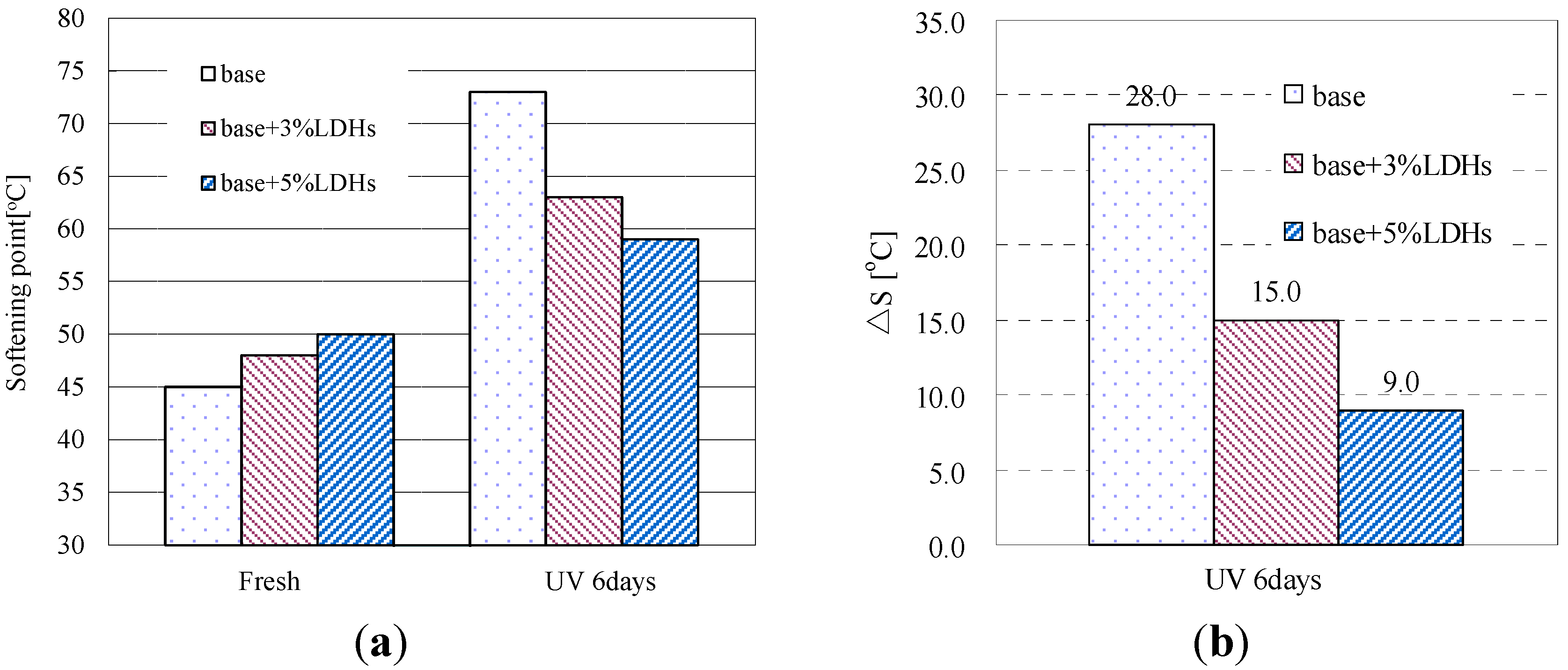
3.6.2. Chemical Properties
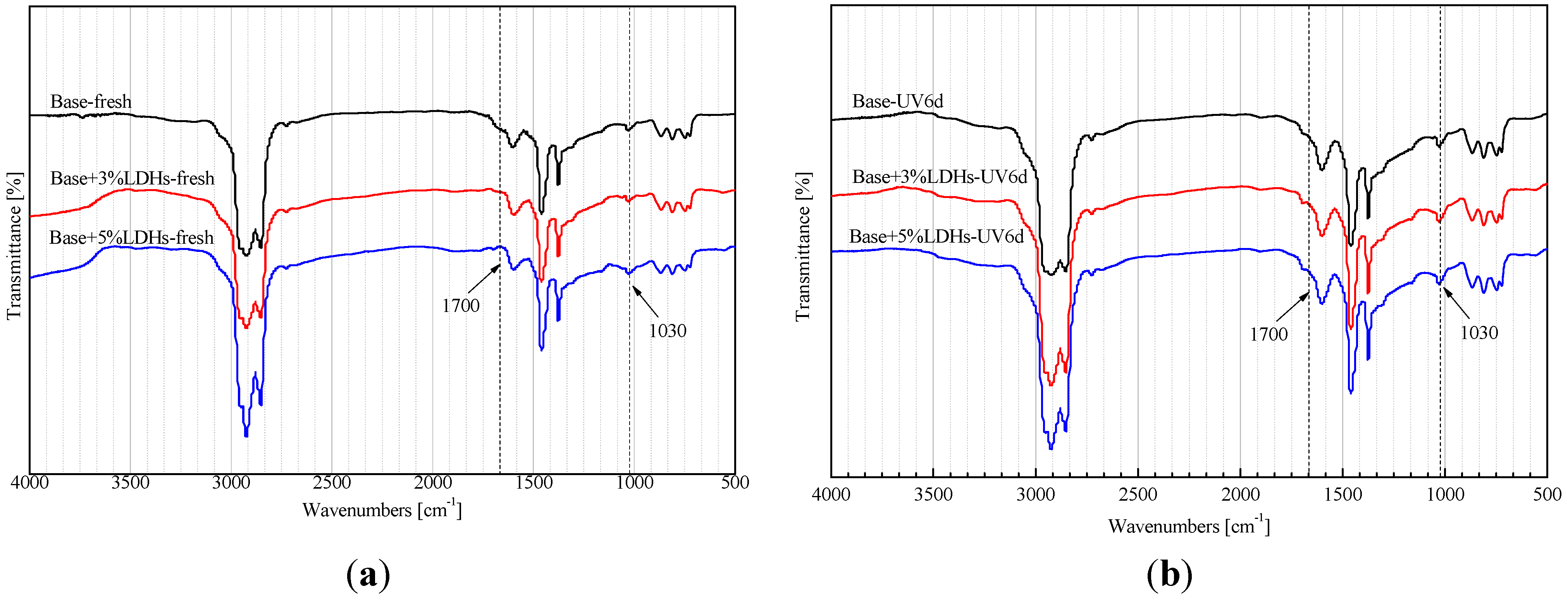
| Sample | Index | Fresh | UV Aging |
|---|---|---|---|
| base | IC=O | 0.0036 | 0.0220 |
| IS=O | 0.0100 | 0.0480 | |
| Base + 3% LDHs | IC=O | 0.0036 | 0.0199 |
| IS=O | 0.0100 | 0.0396 | |
| Base + 5% LDHs | IC=O | 0.0037 | 0.0160 |
| IS=O | 0.0100 | 0.0300 |
4. Conclusions
Acknowledgments
Author Contributions
Conflicts of Interest
References
- Lu, X.; Isacsson, U. Chemical and rheological evaluation of ageing properties of SBS polymer modified bitumens. Fuel 1998, 77, 961–972. [Google Scholar] [CrossRef]
- Lu, X.; Isacsson, U. Artificial aging of polymer modified bitumens. J. Appl. Polym. Sci. 2000, 76, 1811–1824. [Google Scholar] [CrossRef]
- Wu, S.P.; Pang, L.; Mo, L.T.; Chen, Y.C.; Zhu, G.J. Influence of aging on the evolution of structure, morphology and rheology of base and SBS modified bitumen. Constr. Build. Mater. 2009, 23, 1005–1010. [Google Scholar] [CrossRef]
- Durrieu, F.; Farcas, F.; Mouillet, V. The influence of UV aging of a styrene/butadiene/styrene modified bitumen: Comparison between laboratory and on site aging. Fuel 2007, 86, 1446–1451. [Google Scholar] [CrossRef]
- Cortizo, M.; Larsen, D.; Bianchetto, H.; Alessandrini, J. Effect of the thermal degradation of SBS copolymers during the ageing of modified asphalts. Polym. Degrad. Stab. 2004, 86, 275–282. [Google Scholar] [CrossRef]
- Mouillet, V.; Farcas, F.; Besson, S. Ageing by UV radiation of an elastomer modified bitumen. Fuel 2008, 87, 2408–2419. [Google Scholar] [CrossRef]
- Shi, W.; Lin, Y.; Zhang, S.; Tian, R.; Liang, R.; Wei, M.; Evans, D.G.; Duan, X. Study on UV-shielding mechanism of layered double hydroxide materials. Phys. Chem. Chem. Phys. 2013, 15, 18217–18222. [Google Scholar] [CrossRef] [PubMed]
- Yu, J.Y.; Feng, P.C.; Zhang, H.L.; Wu, S.P. Effect of organo-montmorillonite on aging properties of asphalt. Constr. Build. Mater. 2009, 23, 2636–2640. [Google Scholar] [CrossRef]
- Yamaguchi, K.; Sasaki, L.; Meiarashi, S. Mechanism of asphalt binder aging by ultraviolet irradiation and aging resistance by adding carbon black. J. Jpn. Petrol. Inst. 2004, 47, 266–273. [Google Scholar] [CrossRef]
- Zhang, L.; Lin, Y.; Tuo, Z.; Evans, D.G.; Li, D. Synthesis and UV absorption properties of 5-sulfosalicylate-intercalated Zn–Al layered double hydroxides. J. Solid State Chem. 2007, 180, 1230–1235. [Google Scholar] [CrossRef]
- Feng, Y.; Li, D.; Wang, Y.; Evans, D.G.; Duan, X. Synthesis and characterization of a UV absorbent-intercalated Zn–Al layered double hydroxide. Polym. Degrad. Stabil. 2006, 91, 789–794. [Google Scholar] [CrossRef]
- Chai, H.; Xu, X.; Lin, Y.; Evans, D.G.; Li, D. Synthesis and UV absorption properties of 2,3-dihydroxynaphthalene-6-sulfonate anion-intercalated Zn-Al layered double hydroxides. Polym. Degrad. Stabil. 2009, 94, 744–749. [Google Scholar] [CrossRef]
- Wang, B.; Zhang, H.; Evans, D.G.; Duan, X. Surface modification of layered double hydroxides and incorporation of hydrophobic organic compounds. Mater. Chem. Phys. 2005, 92, 190–196. [Google Scholar] [CrossRef]
- Ay, A.N.; Zümreoglu-Karan, B.; Temel, A.; Mafra, L. Layered double hydroxides with interlayer borate anions: A critical evaluation of synthesis methodology and pH-independent orientations in nano-galleries. Appl. Clay Sci. 2011, 51, 308–316. [Google Scholar] [CrossRef]
- Xu, S.; Sun, Y.B.; Yu, J.Y. The effect of zinc doped Mg-Al LDHs on ultraviolet aging resistance of asphalt. Petrol. Sci. Technol. 2015, 33, 335–343. [Google Scholar] [CrossRef]
- Wang, G.R.; Rao, D.M.; Li, K.T.; Lin, Y.J. UV blocking by Mg-Zn-Al layered double hydroxides for the protection of asphalt road surfaces. Ind. Eng. Chem. Res. 2014, 53, 4165–4172. [Google Scholar] [CrossRef]
- Standard Test Method for Thin Film Oven Test of Bituminous Materials; ASTM D1754/D1754M-09; ASTM: West Conshohocken, PA, USA, 2009.
- Standard Test Method for Penetration of Bituminous Materials; ASTM D5-06; ASTM: West Conshohocken, PA, USA, 2006.
- Standard Test Method for Softening Point of Bitumen (Ring-and-Ball Apparatus); ASTM D36-09; ASTM: West Conshohocken, PA, USA, 2009.
- Mouillet, V.; Lamontagne, J.; Durrieu, F.; Planche, J.P.; Lapalu, L. Infrared microscopy investigation of oxidation and phase evolution in bitumen modified with polymers. Fuel 2008, 87, 1270–1280. [Google Scholar] [CrossRef]
© 2015 by the authors; licensee MDPI, Basel, Switzerland. This article is an open access article distributed under the terms and conditions of the Creative Commons Attribution license (http://creativecommons.org/licenses/by/4.0/).
Share and Cite
Liu, X.; Wu, S.; Liu, G.; Li, L. Optical and UV-Aging Properties of LDH-Modified Bitumen. Materials 2015, 8, 4022-4033. https://doi.org/10.3390/ma8074022
Liu X, Wu S, Liu G, Li L. Optical and UV-Aging Properties of LDH-Modified Bitumen. Materials. 2015; 8(7):4022-4033. https://doi.org/10.3390/ma8074022
Chicago/Turabian StyleLiu, Xing, Shaopeng Wu, Gang Liu, and Liping Li. 2015. "Optical and UV-Aging Properties of LDH-Modified Bitumen" Materials 8, no. 7: 4022-4033. https://doi.org/10.3390/ma8074022
APA StyleLiu, X., Wu, S., Liu, G., & Li, L. (2015). Optical and UV-Aging Properties of LDH-Modified Bitumen. Materials, 8(7), 4022-4033. https://doi.org/10.3390/ma8074022







